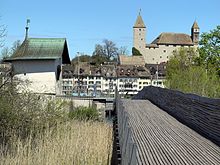Heilig Hüsli
| Heilig Hüsli | |
|---|---|
 Holzbrücke Rapperswil-Hurden, Seedamm to the left, Heilig Hüsli and Rapperswil respectively Rapperswil Castle and Lindenhof hill in the background | |
 | |
| Country | Switzerland |
| Denomination | Catholic Church |
| Churchmanship | Chapel |
| Administration | |
| Diocese | Chur |
| Parish | Rapperswil |
Heilig Hüsli (Holy house) is a bridge chapel in Rapperswil, Canton of St. Gallen, Switzerland.

Geography
The chapel is located next to the so-called Seedamm at the Rapperswil railway station, and as of the today it is situated on a small island on upper Lake Zürich (Obersee) on the Holzbrücke Rapperswil-Hurden, a historical wooden bridge that was reconstructed in 2001.
On occasion of the formation of the Alps, the fossilized sediments material of the body of water between the Ricken and Etzel chains unfolded. There arose the typical rock bands that form the Lindenhof hill in Rapperswil, or the islands of Ufnau, Lützelau and Heilighüsli. During the last Ice Age the island was under a thick layer of ice, and the hard layers of conglomerate rock and the sandstone ridge survived the sanding by the glacier.[1]
History
The chapel on the former medieval wooden bridge between Rapperswil and Hurden was first mentioned in 1485 AD as a wooden prayer house respectively pilgrim's chapel. The Jakobsweg (Way of St. James) leads through the region of Lake Zürich: From Wattwil over the Ricken Pass to Schmerikon on to Lachen and Buechberg along the left bank of the upper lake to St. Meinrad Pass, or from Schmerikon along Obersee, passing Bollingen, Wurmsbach and Jona-Busskirch to Rapperswil and then crossing the wooden bridge towards Hurden. Another route leads over the Hörnli mountain through the Töss Valley, passing the former Rüti Abbey via Kempraten and Rapperswil and the wooden bridge to the St. Meinrad Pass towards the Einsiedeln Abbey.
As recorded by an inscription, the present stone building dates back to 1551. After a legal dispute over a pasture of the so-called Wydenchlösterli on the shore of the Jona River the chapel became even the site of an execution. Wydenchlösterli was a small Beguine nunnery which was given by the House of Rapperswil. In the years before the Reformation in Zürich, Katharine Scheuchzer was its last superior, and she fought that the nunnery should be dissolved, even asked the neighbouring Rüti Abbey and the Old Swiss Confederacy for support. When an epidemic in the Rapperswil hospital broke out, Katharine Scheuchzer (Katharina Schüchter) was accused by thoughtless remarks and false accusations in 1563 as a witch.[2] Although even the Tagsatzung's verdict of 1543 was in favour of the small nunnery, after cruel torture, the old woman was sentenced by the town council to death, and put in a bag and drowned in the Obersee lake at the Heilig Hüsli chapel. The property of the nunnery went over to the hospital.[3]
After the Seedamm was built in 1878, the Heilig Hüsli chapel was the only remaining structure of the medieval wooden bridge. It stood isolated in the lake and was not accessible to visitors until the reconstruction of the former wooden bridge was erected in 2001.
Architecture
The chapel stands on an approximately 4 metres (13 ft) high base, measures just 2 metres (7 ft) x 3 metres (10 ft), with an eaves height of about 3.5 metres (11 ft), and it has a west-facing apse, in which a miraculous fresco once was issued. The altarpiece whose outlines are visible in the interior, is issued together with a representation of the Virgin Mary with the body of Christ in the Stadtmuseum Rapperswil-Jona. It was replaced by a replica of the Swiss artist Marlies Pekarek, inaugurated and blessed on 7 April 2011 with the intention to return the bridge chapel to its original purpose.[4] The interior of the chapel is visible only through the latticed east side, and an old custom following, coins are thrown by pilgrims into the interior.

-
The bridge chapel, Seedamm and Rapperswil in the background
-
The wooden bridge, as seen from nearby Seedamm, Obersee and Wägital in the background
-
Fresco inside the chapel
-
As seen from Schloss Rapperswil
As of today the small chapel is owned by the Ortsgemeinde (citizenry's community) Rapperswil. The chapel was partially renewed in 1908, 1930, 1957, 2011 and 2015.
Cultural heritage
The chapel is under protection since 1907 and the building itself is listed in the Swiss inventory of cultural property of national and regional significance as an object of regional importance.[5] Apart from that, the site of the chapel is part of the Seedamm area including the remains of the prehistoric wooden bridges respectively stilt house settlement Rapperswil-Jona-Technikum.[6][7]
References
- ^ Verein Freunde der Insel Ufnau. "Willkommen auf der Ufnau – ein abwechslungsreicher Rundgang" (PDF) (in German). ufnau.ch. Retrieved 2015-10-08.
- ^ "...schantlichs leben und hushan, mit huren und buben husghan, darzu jr dz almusen zu Rüti. Stadtarchiv Rapperswil, A VIIa 1.
- ^ "Rechtsquellen der Stadt und Herrschaft Rapperswil (mit den Höfen Busskirch/Jona, Kempraten und Wagen)" (in German). Rechtsquellenstiftung des Schweizerischen Juristenvereins. Retrieved 2015-08-15.
- ^ "Rapperswil Heilig Huesli" (in German). art-tv.ch. 2011-04-09. Retrieved 2015-08-15.
- ^ "B-Objekte KGS-Inventar" (PDF). Schweizerische Eidgenossenschaft, Amt für Bevölkerungsschutz. 2015-02-18. Retrieved 2015-09-18.
- ^ palafittes.org: Fundstellen Schweiz im UNESCO-Weltkulturerbe: Rapperswil-Jona/Hombrechtikon–Feldbach (Seegubel, CH-SG-01), Rapperswil-Jona-Technikum (CH-SG-02), Freienbach-Hurden-Rosshorn (CH-SZ-01) in connection with the prehistorical lake crossings. Retrieved 2015-08-15.
- ^ "Schweizerisches Inventar der Kulturgüter von nationaler Bedeutung: Kanton St. Gallen, A-Objekte" (PDF) (in German). bevoelkerungsschutz.admin.ch. 2015-01-01. Retrieved 2015-09-14.
External links
- Buildings and structures completed in 1551
- 15th-century churches
- Roman Catholic churches in Switzerland
- Buildings and structures in Rapperswil-Jona
- Cultural property of regional significance in the canton of St. Gallen
- Churches in the canton of St. Gallen
- Chapels in Switzerland
- Lake islands of Switzerland
- Islands of Lake Zurich
- 1551 establishments in the Holy Roman Empire




